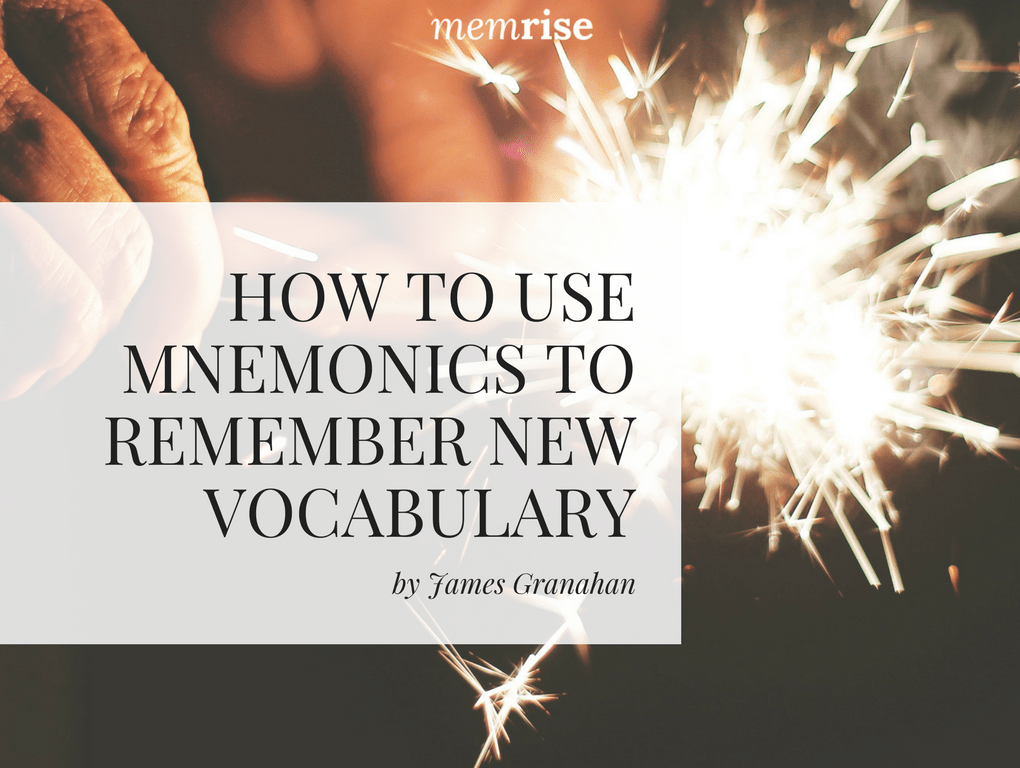No matter what language you’re learning you’re going to need words and lots of them!
But all too often it can feel like new words just go in one ear and out the other.
It’s easy to blame yourself or your memory for this, but in actual fact, it’s not your memory that’s letting you down.
You see, if you want to remember new words, reading and repeating them once or twice isn’t enough. You need to bring attention to them and create associations that will allow your brain to easily recall them when you need them.
The greater the association you can create between the words you want to learn and something you already know, the easier it’ll be to remember those words. That’s why using mnemonics is such a powerful way to learn new vocabulary.
What are mnemonics?
A mnemonic is a pattern, idea or association that you use to help you remember something.
There are two basic types of mnemonics that we can use in language learning.
- Word Associations
- Mnemonic images
And what better place to talk about mnemonics than on the Memrise blog! Memrise already incorporates mnemonics into its learning platform. You know those wacky images or sentences that sometimes appear when you start learning a new word in Memrise?
Those are mnemonics! Basically, mnemonics are connections you make that you can use to remember something.
Mnemonics work because the brain remembers things much more effectively when you bring attention to them and connect them with images and existing knowledge.
“As bad as we are at remembering names and phone numbers and word-for-word instructions from our colleagues, we have really exceptional visual and spatial memories.”
― Joshua Foer, ‘Moonwalking with Einstein: The Art and Science of Remembering Everything’
In a nutshell, this means that if you can create a wacky image for a word you want to learn or if you can connect it with a piece of information you already know, you’re far more likely to remember it.

How can mnemonics help you learn a foreign language?
Take a look at the French example in the image above. On its own, the word santé isn’t particularly easy to remember. But when you connect it with an image of Santa and Rudolph kicking back with a couple of beers, it becomes practically impossible to forget!
Now all you have to do is recall that image of Santa saying santé and voilà, you’ve remembered the word!
Best of all, mnemonics can be used to help you remember many different elements of a language such as:
- The pronunciation and meaning of new vocabulary
- The genders of words
- Verb or case endings
Practical examples of mnemonics in language learning
Creating mnemonics for words you want to learn can be time-consuming at first, especially when creating images instead of just simple word associations. Just keep at it and you’ll find that you become faster at it the more you practice.
Let’s look at some practical examples to demonstrate how you might go about creating good mnemonic images.
Here’s a mnemonic I created to help me remember the Spanish phrase de pie, which means ‘standing’.
The first step is to listen to how the word is pronounced and see if the word or any parts of the word sound similar to words you know in your native language. You can start creating associations by linking these sounds to words you already know.
In this case, I although the pronunciation is different pie immediately reminds me of the English word ‘pie’. Who doesn’t love a good pie after all?! This is a great place for me to start my mnemonic because I can easily create an image from this word. Most of us can imagine a warm pie fresh out of the oven and the smell of gravy, pastry and fresh vegetables.
Next, I need to figure out to remember the preposition de. The first thing that came to mind for me was the name Denzel, and this makes me thing of the actor, Denzel Washington.
So now I have images for both parts of the phrase I want to learn: ‘Denzel Washington’ for de and a freshly baked pie for pie.
But what about the meaning of the phrase? So far, I’ve created an image that will definitely help me remember the phrase itself but how am I supposed to remember what it means?
The answer is that I need to add combine my images and add some action.
So, I picture Denzel Washington standing in a freshly baked pie. All I have to is picture him standing there to remember the meaning of the word. To make the image more graphic I might imagine the look on his face as he say’s ‘ugh, my feet are covered in gravy!’. This image is pretty wacky, but that’s a good thing! The crazier your image, the easier it will be for you to remember.
Using Mnemonics to learn grammar
As I already mentioned, you can use mnemonics to learn more than just individual words. You can also use them to memorise tricky grammar elements such as the genders of words.
If you’ve ever studied a Romance language like Spanish or French you’ve likely cursed word gender at some point or another! Well, not anymore.
A great way to remember the gender of words is to create a specific element which you can add to all your mnemonics to indicate whether the word is masculine or feminine.
I recently applied this to Russian while learning masculine and feminine case endings. Any mnemonic images I create for masculine endings feature John F. Kennedy, while any mnemonics for feminine words feature Marilyn Monroe.
The characters in my images will remind me of the gender and their actions will remind me of the word itself and its meaning and pronunciation.
So, for example, to remember the masculine pronoun ‘моему’ (mo-yemu)’ I created an image of JFK (masculine) riding an emu (-yemu) and shouting loudly ‘this is, eh, … my emu!’ in his New England accent.

Crazy? Undoubtedly! But it’s also incredibly easy to remember and that’s what’s most important.
Applying this technique to your own learning
It’s very easy to apply these things techniques to your own learning right away. All you need are some new words to learn and a little imagination!
If you’re using Memrise, you can even add your mnemonics to the words you’re learning in the app or use mnemonics that other users have already created for these words.
At first, creating these images and associations will take time. Like any skill, you need to practice!
So don’t worry if at first, it takes you 5 minutes to come up with a mnemonic for each word. The more you do it, the easier it will become and soon you’ll be creating these associations in a matter of seconds.

James Granahan is a language learning coach and blogger from Ireland. He’s fascinated by the mindset side of language learning and methods for learning more effectively. He loves learning about new cultures through their languages and is passionate about travel and history.
You can read more of his tips on memory and many other language learning topics at Lingua Materna . You can also find him on Facebook!









